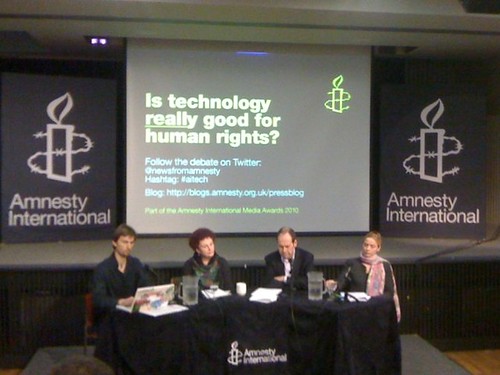Technology and human rights at Amnesty
On Monday it was a pleasure to be in the audience for Amnesty International‘s event “Is technology really good for human rights?“
Perhaps a few years ago, the answer would have been an overwhelming ‘yes’ from most and a very strong ‘no’ from the odd dissenter or two. Yet at the panel – chaired by Rory Cellan-Jones and with a platform shared by Kevin Anderson, Annabelle Sreberny, Susan Pointer and Andrew Keen – there was a marked measure of maturity and of shared ground between diverse voices.
Andrew Keen has long been one of the most prominent critics of the emergence of social media and the clamour around it, but, over the phone from Washington, provided a balanced view that information technology has been used as much by oppressive governments against their people as it has been used for those fighting for human rights. Keen enthusiastically cited Evgeny Morozov, who talked at last year’s Demos event on the internet’s effect on politics, and is well known for his critique of the Internet in oppressive countries.
But I’d argue there’s something more intrinsic than this. Personally, I believe technologies are not by default open-ended and neutral; they are designed with their designers’ politics and values embedded within them. However they can be co-opted and transformed in their implementation, contrary to their original intent, to wield power. And if technologies didn’t have power for ordinary people, then governments wouldn’t be so keen to restrict their use, whether through technical means – such as blocking and censoring social sites, or the more old-fashioned way like jailing and torturing bloggers (a fact which also shows that governments cannot rely on technology alone to oppress).
This view of technology as a tool was shared by Google’s Susan Pointer, who stressed the important of working together to keep the Internet healthy and continuing to democratise the media. But I found “democracy” an odd word to use – nobody voted for Google to be the number-one site in the world, and there do not exist the systemic checks and balances that exist in a democracy; although there are informal checks on their power, from word of mouth to the comparative quality of their rivals, these are agreed by the community at large, not mandated by the rule of law.
“Anarchy” is often used to describe the online world but even this has its flaws; power and influence are still wielded disproportionately by certain individuals and communities, from celebrities on Twitter spreading good causes and campaigns, to the power users of Digg linking the latest news stories, to the meme-creators of 4chan. There is still inequal power, it’s just distributed and allocated in a different way.
Maybe there’s no right word, no right theory to describe this – yet. Kevin Anderson argued quite correctly that despite digital’s pervasiveness, it’s just too early for us a society to fully get to grips for the implications it has had on social interactions; any key to making digital communications effective for human rights depends on making virtual actions correspond to real ones and this is something we’re still learning.
Perhaps slightly pessimistically, I think that as we push the networked and physical worlds closer together, and the boundary between the two blurs more, it will create further tensions, and not just with oppressive regimes in the fight for basic human rights, but closer to home and different sets of rights as well – witness the clash of cultures taking place right now over the Digital Economy Bill in the UK. But the struggle for human rights is the high watermark of this set of tensions, and consequently the one that attracts the most attention and hence both hype and detraction.
So when stories such as Twitter powering a possible revolution break, and a regime is not toppled, there is inevitably the retrospective criticism that Twitter, or digital technologies in general, fail to promote human rights. Annabelle Sreberny’s account of the Iranian demonstrations however show that the story was much more complex and added some much-needed colour. Before the election demonstrations had taken place in 2009, the Internet had proven vital in organising likeminded people without face-to-face communications, through Iran’s network of bloggers and YouTube users, supported by a sympathetic and well-mobilised Iranian diaspora. The immediacy of Twitter and its similarity to the spontaneity of the protests caught the interest of Western observers, but the grassroots communities, that had formed around their cause, was part of a much longer-term struggle over many years, and that it’s not over yet by any means. Saying Twitter ‘failed’ to liberate Iran is to miss the point entirely.
So what about the answer to the question? Kevin Anderson’s assertion that the Internet had been a net good was met with no disagreement, and even Andrew Keen wouldn’t stretch as far as saying that technology had damaged human rights. Technology alone achieves little, though, and no single technology or website is going to make the difference. People are what make the difference, but it takes the technology to help them make that difference; how the two work together and they use the tools designed for them are what counts, creating the right combination of people’s will and technology. If they don’t fit together for whatever reason – a lack of people with the right skills or connectivity (as is the case in much of sub-Saharan Africa), or an inability to translate sentiment to action (what was widely panned as ‘slacktivism’) – then no breakthrough will be achieved. Getting that fit right is the key to making sure that the answer to the question will be ‘yes’.
